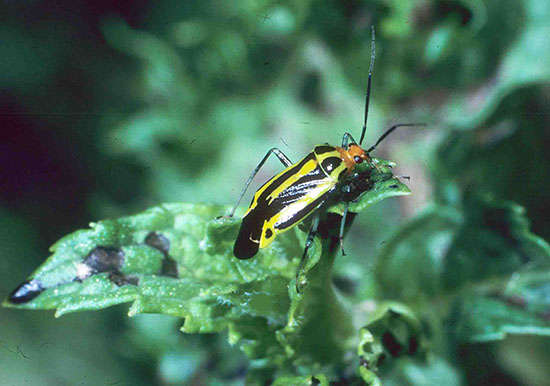Issue 7, June 11, 2018
Fourlined Plant Bug
We have spotted the fourlined plant bug (Poecilocapsus lineatus) doing unsightly damage to a favored garden plant. These fourlined plant bugs are aptly named for the four black lines that run down the leathery part of the adults' wings. The outer two lines end with a dot and the two inner ones end where the membranous part of the wings starts. The lines of the adult fourlined plant bug can be bright green to bright yellow. The body of the nymphal stage can be bright red and develops the four lines as it matures.

Fourlined plant bug adult on mint.
Eggs overwinter in the stems of affected plants. This time of year, they hatch, begin feeding and remain active for a short period as there is only one generation per year. Fourlined plant bugs favor feeding on plants in the mint or aster family but will feed on a wide range of ornamentals. The feeding damage may be all that you see because they tend to hide in the leaf axils.
This is a "true bug" which can be identified by their piercing, sucking, mouthparts and wings that are half-leathery and half-membranous. Their mouthparts form a conspicuous beak that runs along the underside of the body when they are not feeding. The piercing sucking mouthparts allow the insect to feed on plant fluids. They produce dark round sunken spots on the leaves after feeding. The spots may be clear then form a depression as the plant bug sucks out the chlorophyll. Even through this bug causes lots of damage it is considered just an aesthetic problem and unless populations are extremely high control may not be necessary. However, control options are as follows:
- Cut back plants in the fall to remove eggs from the landscape. The eggs are laid in the tender stems before the population dies out. Remove any leaf litter left behind from the growing season.
- Do nothing and allow nature take its course. Natural predators include a parasitic wasp whose larvae feast on fourlined plant bug eggs and possibly spiders.
- Spray insecticidal soap or permethrin when nymphs are seen.
- A hard water stream can knock nymphs of the plants making it hard for them to re-establish.
(Kelly Allsup)
Author:
Kelly Allsup